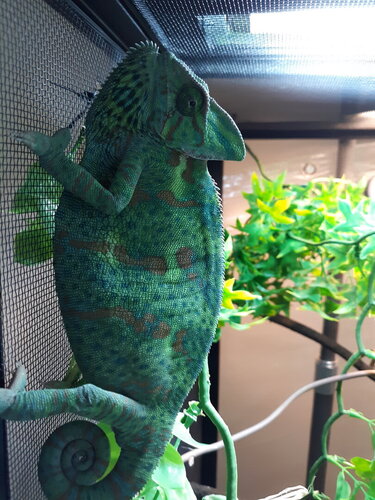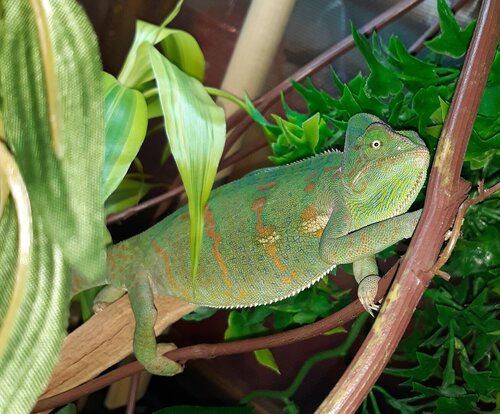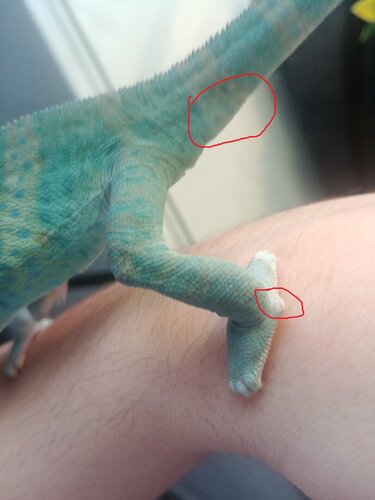I have a female veiled chameleon and I've noticed that she has started having small dark brownish dots on her veil and close to her eye. I've seen pictures of parasytes and this doesn't seem to be it. She has just finished shedding her skin so I thought it could be that, but still she seems a bit off today. She ate enough but doesn't seem to want to drink and isn't very active. Do I have anything to worry about?
Navigation
Install the app
How to install the app on iOS
Follow along with the video below to see how to install our site as a web app on your home screen.
Note: This feature may not be available in some browsers.
More options
You are using an out of date browser. It may not display this or other websites correctly.
You should upgrade or use an alternative browser.
You should upgrade or use an alternative browser.
Chameleon has weird black dots on her skin cells
- Thread starter Lichisor
- Start date
nightanole
Chameleon Enthusiast
Looks like a happy healthy girl. The ridges will turn grey and black, and continue to do so as they age. They will not be "flesh colored" for long.
That makes me feel relievedLooks like a happy healthy girl. The ridges will turn grey and black, and continue to do so as they age. They will not be "flesh colored" for long.
nightanole
Chameleon Enthusiast
That makes me feel relievedWe provide her with all she needs and she's a lovely little girl

Dont worry, we have several posts a year where the cham has grey front, and then as time goes by, they start getting grey "back of crest" or over the eyes, and have panics.

MissSkittles
Chameleon Enthusiast
Hello and welcome. Are you sure you have a female? Looks like a male to me. Are there any nubs on the back feet? Are you able to post a picture of the back feet?I have a female veiled chameleon and I've noticed that she has started having small dark brownish dots on her veil and close to her eye. I've seen pictures of parasytes and this doesn't seem to be it. She has just finished shedding her skin so I thought it could be that, but still she seems a bit off today. She ate enough but doesn't seem to want to drink and isn't very active. Do I have anything to worry about?
Ah damn here we go again...Hello and welcome. Are you sure you have a female? Looks like a male to me. Are there any nubs on the back feet? Are you able to post a picture of the back feet?
I posted something a week or two ago and said it was a male. Then EVERYONE told me it's a she even tho she has very little spurs on her back legs and I initially thought she was a male. Dunno buddy xD
There ya goLooks male to me. Chin spike are large and the body is coloring up like a male. I went back to an older thread where you posted a pic of the back feet and there is a very noticeable spur...
Just humor me, post a new photo of the back foot.
Attachments
MissSkittles
Chameleon Enthusiast
Lol. Sorry. I didn’t realize it was an earlier debate. Males have the defined vertical bands of color, like your does while females have more horizontal lines with some splotchy horizontal. Males have a larger casque. Some females can have tiny tarsal spurs...males are usually more pronounced. Yours does have a little spur. Based on everything, I’m going with male.Ah damn here we go again...
I posted something a week or two ago and said it was a male. Then EVERYONE told me it's a she even tho she has very little spurs on her back legs and I initially thought she was a male. Dunno buddy xD
Pics of my girl at her most colorful (receptive) for comparison


MissSkittles
Chameleon Enthusiast
LolMy poor cham is having an existential crisis, is it a he or a she? We've switched names from male to female so I wanna know
MissSkittles
Chameleon Enthusiast
@Brodybreaux25 What do you think? Male or female?
Brodybreaux25
Chameleon Enthusiast
Male dots are normal
Sexual dimorphism in Chamaeleo calyptratus alias
Sexing Yemen chameleons
In the Yemen chameleons, the sexes differ in many features from each other. They show the s.c. Primary sexual dimorphism, which is expressed through
the presence of sexual glands (testes with ductus deferens in males and ovaries with oviducts in females) and copulatory organs (hemipenes in males, hemiclitoris in females).
The problem for sexing animals is, that some of these organs (first group) are situated in the body cavity and some (the second group) in special pockets at the base if the tail, none of them are invisible from outside. There is a technique how to evert the hemipenis, but in young animals and in animals which are dehydrated, old or out of breeding season, it does not work reliably, plus, it might be painful for the animal and is definitely rather stressful, especially if done by an inexperienced owner, therefore not recommended.
Fortunately, there are several Secondary sexual characteristics, that allow us to define the sex rather reliably, especially in adult animals:
SIZE The males are much bigger than the females, they can reach up to 30in / 19in resp, usually stay much smaller
BODY PROPORTIONS The females are built more slender with smaller heads
TAIL BASE Due to the presence of male copulatory organs, hemipenes, the tail base behind cloacal is thicker/swollen in males
TARSAL SPUR Males have a prominent knob-like protuberance on the heels, while female lack them. This characteristic is is well
Visible from hatchlings already. Through inbreeding and improper incubation temperatures and regime, however, we can see more and more females with differently developed spurs as well as males with small or lacking spurs.
CASQUE The casque in males is much higher than in females. Through mistakes in incubation and after sterilization, some females can grow very high casques and resemble a fully developed casque of males.
DORSAL CREST The conical scales on the dorsal crest are relatively much bigger in males
GULAR CREST The conical scales on the gular crest are relatively much bigger in males, plus they are usually orange in males and white in females
COLORATION The general pattern is in both sexes same, however due the ability to change the color, some skin areas melt in color with each other. The diagnostic features are: orange spots on the flanks possess only females while bright yellow transversal bands on the flanks are confined to males only.
For reliable sex determination, all aspects need to be taken in consideration. In doubt, ask experienced colleagues in for assistance.
Other species of chameleons possess same primary but partly or fully different secondary sexual characteristics...
The left column relates always to male, the right to females
They show the differences(top down) in:
Table 1:
General habitus
Head form and casques relative size Tarsal spurs
Table 2: Gular crest Tail base Dorsal crest


Sexual dimorphism in Chamaeleo calyptratus alias
Sexing Yemen chameleons
In the Yemen chameleons, the sexes differ in many features from each other. They show the s.c. Primary sexual dimorphism, which is expressed through
the presence of sexual glands (testes with ductus deferens in males and ovaries with oviducts in females) and copulatory organs (hemipenes in males, hemiclitoris in females).
The problem for sexing animals is, that some of these organs (first group) are situated in the body cavity and some (the second group) in special pockets at the base if the tail, none of them are invisible from outside. There is a technique how to evert the hemipenis, but in young animals and in animals which are dehydrated, old or out of breeding season, it does not work reliably, plus, it might be painful for the animal and is definitely rather stressful, especially if done by an inexperienced owner, therefore not recommended.
Fortunately, there are several Secondary sexual characteristics, that allow us to define the sex rather reliably, especially in adult animals:
SIZE The males are much bigger than the females, they can reach up to 30in / 19in resp, usually stay much smaller
BODY PROPORTIONS The females are built more slender with smaller heads
TAIL BASE Due to the presence of male copulatory organs, hemipenes, the tail base behind cloacal is thicker/swollen in males
TARSAL SPUR Males have a prominent knob-like protuberance on the heels, while female lack them. This characteristic is is well
Visible from hatchlings already. Through inbreeding and improper incubation temperatures and regime, however, we can see more and more females with differently developed spurs as well as males with small or lacking spurs.
CASQUE The casque in males is much higher than in females. Through mistakes in incubation and after sterilization, some females can grow very high casques and resemble a fully developed casque of males.
DORSAL CREST The conical scales on the dorsal crest are relatively much bigger in males
GULAR CREST The conical scales on the gular crest are relatively much bigger in males, plus they are usually orange in males and white in females
COLORATION The general pattern is in both sexes same, however due the ability to change the color, some skin areas melt in color with each other. The diagnostic features are: orange spots on the flanks possess only females while bright yellow transversal bands on the flanks are confined to males only.
For reliable sex determination, all aspects need to be taken in consideration. In doubt, ask experienced colleagues in for assistance.
Other species of chameleons possess same primary but partly or fully different secondary sexual characteristics...
The left column relates always to male, the right to females
They show the differences(top down) in:
Table 1:
General habitus
Head form and casques relative size Tarsal spurs
Table 2: Gular crest Tail base Dorsal crest
nightanole
Chameleon Enthusiast
My poor cham is having an existential crisis, is it a he or a she? We've switched names from male to female so I wanna know
My tegu is called Mr. Lola for the same reasons
maveroflecha
New Member
Now is they/themMy poor cham is having an existential crisis, is it a he or a she? We've switched names from male to female so I wanna know
Similar threads
- Replies
- 52
- Views
- 2K











